
Andy Lloyd's Dark Star Blog

Blog 78 (November-December 2019)
Is Planet Nine a Black Hole?
Sometimes science likes to outdo fringe researchers. Planet X research occupies a zone of interest which invites some fairly wild ideas - usually about the approaching apocalypse. Scientists who 'believe' in the existence of Planet X (and there are many) prefer to distance themselves from such fanciful notions. Their scientific worldview and training allows them to differentiate between what may be a realistic possibility, and what is, frankly, a load of old nonsense. Scientists then tend to argue amongst themselves about what the current evidence will allow, and what it disqualifies. These arguments then get pretty technical, and are often dynamic as the available evidence shifts around.
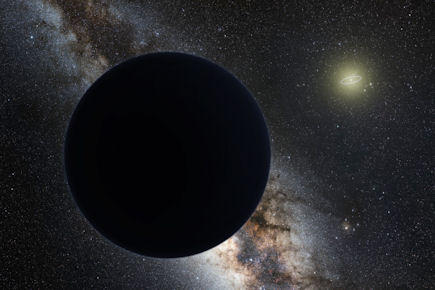
Image Credit: nagualdesign/Tom Ruen/Wikimedia commons
Sometimes, scientists like to jump in the deep end. This is the case with the concept of a distant black hole in the solar system, as advocated by a group recently (1). The reason for making such a wild suggestion is that whatever's causing the anomalies in the outer solar system it must be both: (a) massive in terms of gravitational influence, and (b) dark to the point of being practically invisible. How else to square the circle between the indirect evidence for its existence and its stubborn refusal to pop out of the woodwork?
One might suggest that it is hidden in some physically realistic way (as I have in 'Darker Stars'). One might suggest that its been located and imaged, but that its discovery is being kept a close secret because of the implications for this object's discovery. Or one might argue for other possibilities besides a planet - passing stars, the accumulated gravitational influence of smaller bodies, etc. But a black hole?? Admittedly, this notion involves rather a diminutive black hole - one the size of a tennis ball, or thereabouts.
The idea arise from an excess in the expected number of microlensing effects observed recently by the Optical Gravitational Lensing Experiment (OGLE) in the direction of the galactic bulge (2). Black holes are capable of bending light around themselves, due to their remarkable gravitational influence. If tiny black holes exist, with the mass of a planet, then their size would be that of a cricket or baseball (try catching that in the outfield!). These objects could account for the observed microlensing effects. It's then not too much of a stretch to imagine that one such object could have been captured by the Sun into a distant orbit. These objects could be free-floating planets. The authors of this paper think they might be tiny, primordial black holes.
What particularly interests me here is that the location of the galactic bulge is exactly where I think Planet X is to be found. I've been discussing the merits of the region around the constellation Sagittarius for many years. There are many reasons for this, which I have set out in my books. Microlensing effects in this direction of the sky would be what I would expect if Planet X (and potentially its own collection of moons) is out there. Why need something as exotic as a black hole then? The reason such a world (or worlds) remains hidden is the very fact that this area is just to dense with stars and other astronomical distractions.
Written by Andy Lloyd, 17th November 2019
References:
1) Jake Parks "Planet Nine may be a black hole the size of a baseball" 1 October 2019
2) Jakub Scholtz & James Unwin "What if Planet 9 is a Primordial Black Hole?" 24 Sept 2019
Planet Nine May Lurk In TESS Images
The good news for astrophysicists interested in the possible existence of Planet X is that NASA's Transiting Exoplanet Survey Satellite (TESS) may have already spotted it, without anyone realising. The space satellite has been designed to stare at a particular region of the sky for extended periods of time, imaging as it goes. This makes it an ideal platform for spotting very faint objects moving very slowly across the background field of stars. Although TESS's mission is focused on the discovery of exoplanets orbiting other stars (by carefully watching the paths of stars), it may well pick up distant planetary objects in our own backyard (so long as its near-infrared magnitude is about 21 or better, which may be the case for Planet X). So, good news for those hoping for an early discovery of Planet Nine.
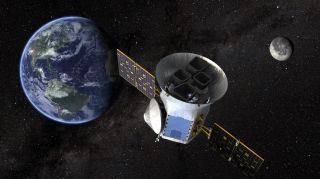
Image Credit: ESO
The bad news? The current database of images which may contain Planet Nine only extends to the southern hemisphere:
"[Harvard University astrophysicist Matt] Holman noted that TESS has already looked at the entire southern hemisphere, making the chances "nearly 100 percent" that Planet 9 has already been observed if it's in that part of the sky. "If it's in the Northern Hemisphere, we're not there just yet," he added." (1)
Actually, that is just fine for the the team at Caltech who set out compelling evidence for the existence of Planet Nine back in 2016. Their best guess for the position of this object is in the constellation of Orion (2), which has been the focus of several sky searches using the Subaru telescope in Hawaii, as yet without success. It's quite possible that this location is not entirely accurate, of course (3).
Written by Andy Lloyd,
17th November 2019
References:
1) Chris Claccia "Planet 9 may have already been found, study suggests" 12 November 2019
2) Konstantin Batygin & Michael Brown "Evidence for a Distant Giant Planet in the Solar System" The Astronomical Journal, 151:2, 20 January 2016,
3) Andy Lloyd "Planet Nine: Are They Digging in the Wrong Place?" 3 July 2017
andylloyd.org/darkstarblog52.htm
Persistent Gas
Yes, it's true: Astronomers are admitting to having trouble with
persistent gas. A very surprising finding about the amount of
gaseous material left lurking around a young star poses fresh new
questions about the scientific consensus on planetary formation (1).
The presence of large quantities of the Carbon 13 isotope has been
identified in the outer part of the 49 Ceti disk. So unusual is
that that this is not just the first time large quantities of Carbon 13
have been discovered around a young star, but it's the first time this
isotope has been discovered in quantity in outer space - usually its
imprint is cloaked by the presence of the normal Carbon 12 isotope which
naturally predominates. The ALMA telescopes have broken new ground
with their high resolution of Carbon 13 atoms.
Image credit: Credit: ALMA (ESO/NAOJ/NRAO), Higuchi et
al.
The implication is that there is a tremendous amount of regular Carbon
12 accompanying it in the gaseous clouds around the 40 million year old
star 49 Ceti (in atomic form, and also in gases like carbon monoxide and
carbon dioxide) - ten times more than expected This gas cloud
shouldn't be there in this kind of quantity. According to the
currently accepted theories of star and planet formation, the gas should
have dissipated long before due to the action of the star's radiation
pressure, leaving just the dust debris disks. The fact that so
much gas is still there is a significant problem theoretically, although
its presence would certainly be a positive factor in planetary
formation, particularly with the formation of gas giant planets like
Jupiter. It appears to indicate that planet formation may be a
longer process than previously thought, due to the persistent
accumulation of gas and dust.
"What is the origin of the gas? Researchers
have suggested two possibilities. One is that it is remnant gas that
survived the dissipation process in the final phase of planet formation.
The amount of gas around 49 Ceti is, however, comparable to those around
much younger stars in the active planet formation phase. There are no
theoretical models to explain how so much gas could have persisted for
so long." (2)
The other possibility under consideration is that this excess material
has resulted from a very significant quantity of collisions but, again,
that solution raises more questions than it answers - the numbers of
collisions required to produce that amount of gas would be staggering.
Written by Andy Lloyd, 24th
December
2019
References: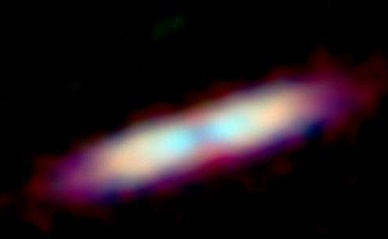
1) Aya E. Higuchi et al. "First Detection of Submillimeter-wave [13C i] 3 P 1–3 P 0 Emission in a Gaseous Debris Disk of 49 Ceti with ALMA", The Astrophysical Journal, (2019)
2) National Astronomical Observatory of Japan "Massive gas disk raises questions about planet formation theory" 23 December 2019
A White Dwarf's Evaporating Planet
In the lifecycle of stars, one of the most dramatic moments is the death throes of a star - its contraction from the swollen red giant down to the puny white dwarf. This ghostly figure is still a powerful object in its own right - dense and hot, and still able to give out plenty of strong radiation. For the fist time, the signs of a Neptune-sized planet has been observed around a white dwarf star, named WDJ0914+1914 (1).
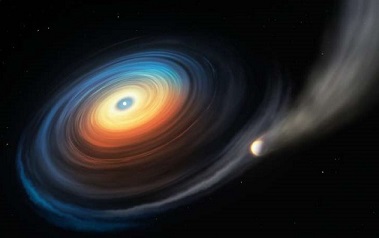
Image credit: Credit: ESO/M. Kornmesser
The planet orbits the white dwarf in just 10 days, at a distance of 15 solar radii from the white dwarf (about 10 million km). Its presence is implied from the observation of a dusty, gaseous debris disk around the white dwarf. Calculations show that this disk cannot be due to the presence of a brown dwarf or, at the other end of the spectrum, a minor planet. The composition of the debris disk shows similarities with the deeper layers of ice giants in the solar system - the implication is that the hidden planet within the disk is Neptune-sized, and is evaporating part of its atmosphere off into space due to the intense radiation pressure of the white dwarf.
What is remarkable about this is that the planet's current location would have been within the star itself during its previous red giant phase:
"According to the
researchers, the exoplanet now found with the help of
ESO's X-shooter orbits the white dwarf at a distance of
only 10 million kilometres, or 15 times the solar
radius, which would have been deep inside the red giant.
The unusual position of the planet implies that at some
point after the host star became a white dwarf, the
planet moved closer to it. The astronomers believe that
this new orbit could be the result of gravitational
interactions with other planets in the system, meaning
that more than one planet may have survived its host
star's violent transition."
(2)
In order for the planet to have survived its parent planet's death
throes, it must have been located within its outer system, then migrated
inwards following the stellar contraction. Given the massive
turbulence going on, it seems unsurprising that any outer planets
fortunate enough to not be swallowed up by the expanding star would then
be perturbed from their usual orbits. But to migrate so far
inwards into the diminished star system is remarkable. This
finding opens up the potential for white dwarfs to be considered as
potential hunting grounds for habitable planets - once all the drama has
subsided, that is. Previously rocky planets may also migrate
inwards following the collapse, or life might get started on moons
around similarly displaced larger worlds.
Written by Andy Lloyd, 24th
December
2019
References:
1) Boris Gansicke et al (2019) Accretion of a giant planet onto a white dwarf. ESO. 4 Dec 2019
2) ESO - Science Release 1919 "First Giant Planet around White Dwarf Found" 4 December 2019
The Turbulent Interstellar Medium
In my latest book 'Darker Stars' I explore the potential for planet formation in interstellar space. My interest in this topic arises from the hypothesis that Planet X might have formed beyond the solar system's heliopause. Essentially, Planet X is an interstellar planet, located as it is beyond the Sun's extensive radiative boundary with the galactic wind. Planets cannot appear out of nowhere, of course - there must be a substantial clumping of material for accretion of interstellar material to occur. But, once a planetessimal seed is in place (and there's plenty of material out there to perform this role, whether it was ejected from the Sun's own sphere, or captured from passing traffic) then the accretion of material could be cumulative over billions of years.
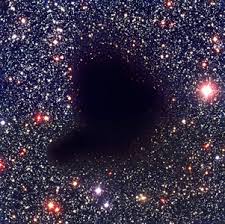
How planets form is still widely debated. But it would seem common sense that their formation is assisted by a non-uniform distribution of materials. A dense cloud of material is much more likely to condense than a diffuse cloud, after all. So, it is good to read about recent findings in cosmochemistry which seem to indicate that the Interstellar Medium (ISM) is indeed non-uniform in its distribution:
"Current models of the diffuse interstellar medium assume uniform layers of ultraviolet illuminated gas with either a constant density or a density that varies smoothly with depth into the cloud. The problem is that the models' predictions often disagree with observations. Decades of observations have also shown, however, that the interstellar medium is not uniform but rather turbulent, with large variations in density and temperature over small distances." (1)
Astronomers tend to think big, and naturally focus upon the formation of stars within collapsing giant molecular clouds. But why could there not also be planet-formation under similar circumstances, arguably much less extreme? One issue is the degree to which any possible accretion may be disrupted by turbulence on the ISM.
"The gas in galaxies is typically seen to be moving at very rapid, even supersonic velocities, providing clear evidence that the medium is highly turbulent. Looking more closely at gas clouds in our own Milky Way, astronomers have similarly demonstrated using a variety of different observations that the interstellar medium is turbulent. Turbulence is a key physical parameter in the star formation process because, like the thermal pressure of warm gas, it counters the collapse of clouds into stars from gravitational contraction." (2)
This indicated the potential power of this kind of turbulence, with materials travelling at supersonic speeds. The idea that material might readily condense and accrete into planets under these circumstances would be fanciful. However, this is a matter of degrees. Local conditions vary, as has been noted, and the presence of a stellar boundary might enable the heiopause to provide something of a haven from the turbulence of the galactic tide, within which a cumulative accretion of ISM could take place around a Planet X object. In other words, within its local environment, the presence of a star can act as a catalyst for ongoing planetary formation beyond its heliosphere.
Written by Andy Lloyd, 24th December 2019
References:
1) Harvard-Smithsonian Center for Astrophysics "Chemistry in the Turbulent Interstellar Medium" 22 November 2019
2) Harvard-Smithsonian Center for Astrophysics "The turbulent interstellar medium" 9 May 2016

You can keep informed of updates by following me on Twitter:
![]()
Or like my Facebook Page: https://www.facebook.com/darkstarandylloyd